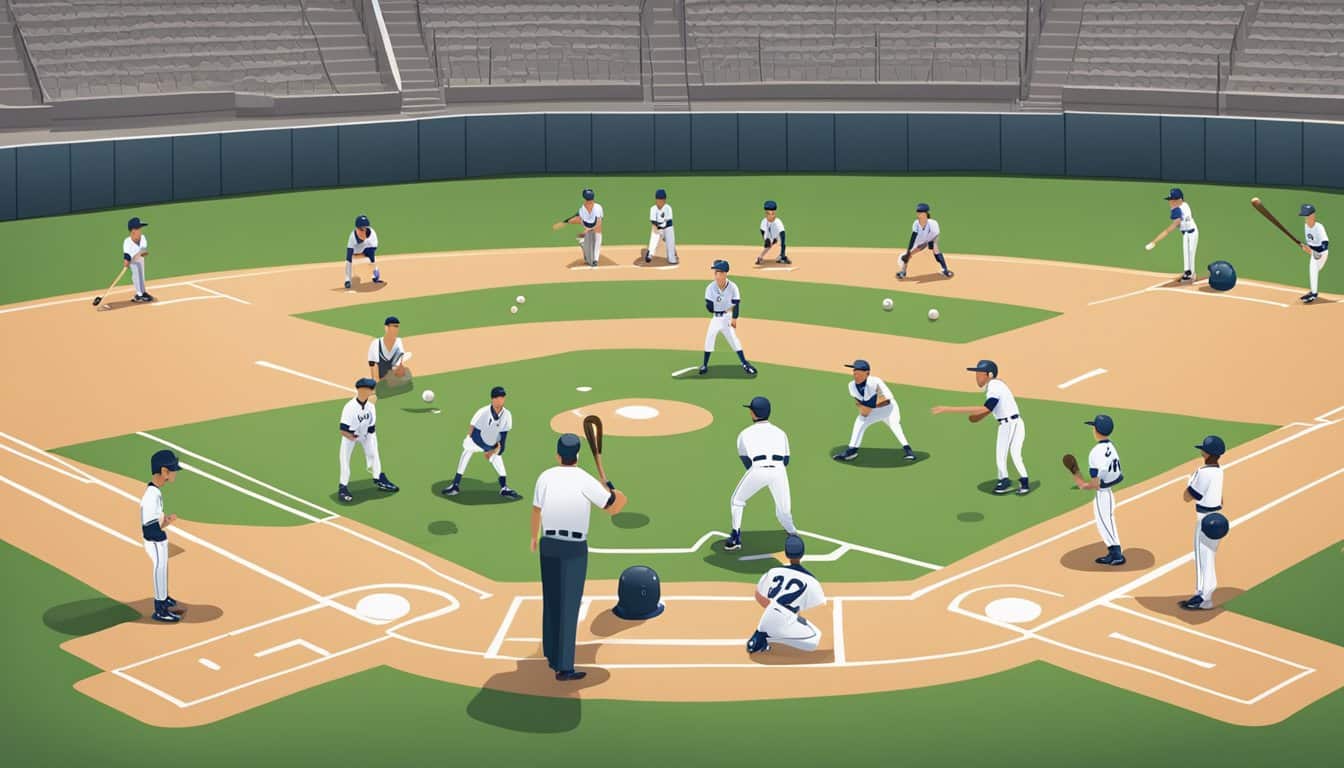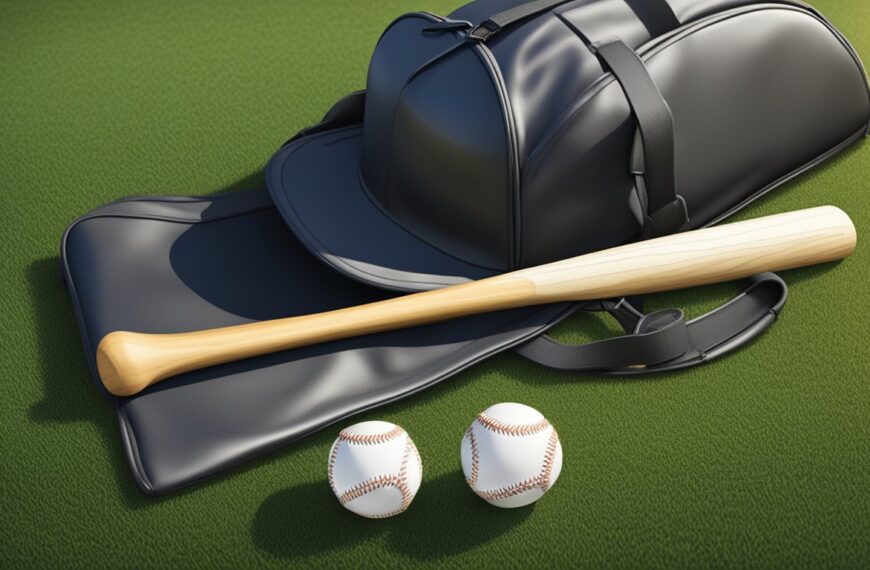Improving one’s batting stance and technique is a fundamental aspect of becoming a proficient hitter in baseball. A proper batting stance sets the foundation for a powerful and accurate swing. It involves alignment of the feet, positioning of the hands, and the readiness of the body to hit the ball as it approaches the plate. The stance should be both comfortable and functional, allowing the batter to move quickly and efficiently.
Using a batting tee can significantly aid in this process. It allows players to practice their swing without the variability of pitches, enabling them to focus on form and consistency. The batting tee is a simple yet effective tool for players to isolate and work on specific aspects of their swing mechanics. By incorporating a tee into regular practice, hitters can make incremental improvements in their footwork, hip rotation, and hand-eye coordination.
Key Takeaways
- A proper batting stance is crucial for a powerful and precise swing.
- Batting tees are effective for isolating and improving swing mechanics.
- Regular practice with a tee enhances footwork, hand-eye coordination, and hitting precision.
Understanding the Basics of a Batting Stance
https://www.youtube.com/watch?v=Bc2NidSLUSc&embed=true
A proper batting stance lays the groundwork for successful hitting in baseball by ensuring balance, power, and readiness to make contact with the ball.
Key Components of a Strong Stance
In a strong batting stance, a player’s feet should be shoulder-width apart, providing a stable foundation. Weight distribution is crucial; balance should be centered with a slight bend in the knees to facilitate quick movements. The hands hold the bat just above shoulder level, and the hips and shoulders align towards the pitcher with the head facing squarely over home plate. This alignment keeps the batter’s eyes level and allows for an efficient swing path. Attention to these elements allows for a smooth transition into the swing, maximizing the potential for hard contact with the ball.
Choosing the Right Bat
It is essential for a batter to choose a baseball bat that complements their size and strength. The right bat should feel comfortable in terms of weight and length, allowing for quick and controlled swings. As general guidance, batters should select a bat they can swing smoothly without strain, while still having enough mass to drive the ball effectively. A table can help match a player’s height with an appropriate bat size.
| Height | Bat Length |
|---|---|
| < 4′ | 28″-30″ |
| 4’1″ – 4’4″ | 29″-31″ |
| 4’5″ – 4’8″ | 30″-32″ |
| 4’9″ – 5′ | 31″-33″ |
| 5’1″ – 5’4″ | 32″-34″ |
| > 5’4″ | 33″-34″ |
Positioning in the Batter’s Box
Correct positioning in the batter’s box impacts a player’s ability to cover the entire strike zone and react to different pitches. A batter should position their feet with enough distance from home plate to allow the bat to cover the outer edge of the strike zone. Too close, and the batter risks getting jammed; too far, and outside pitches become difficult to reach. It’s also essential to stand far enough back in the box to increase the time for pitch recognition, yet not so far that covering the front of the plate becomes challenging.
The Role of the Batting Tee in Practice
https://www.youtube.com/watch?v=hXWwZkQ7rII&embed=true
Utilizing a batting tee can be instrumental in developing a hitter’s technique. It provides a stable platform for players to refine their swing and isolate specific skills.
Introduction to Batting Tees
Batting tees are essential tools for hitters of all levels, from beginners learning the fundamentals to advanced players honing their swing mechanics. The Tanner Tee, a popular choice, is designed to withstand rigorous practice sessions and allows hitters to focus on the ball without the variability of a pitched ball.
Proper Placement and Usage
The placement of the tee is critical in simulating various pitch locations. The tee should be positioned so that the ball is at the hitter’s waist level when the bat makes contact. This means adjusting the height of the tee before each swing to mirror high, middle, and low pitches.
- Proper Tee Height for Different Pitches:
- High pitches: Waist level or slightly higher
- Middle pitches: Center of the strike zone
- Low pitches: Near the knee height
Correct usage also involves aligning the tee with the appropriate part of the plate to practice hitting inside, middle, and outside pitches.
Advancing Skills with Various Drills
Tee work is not just about making contact; it’s about perfecting the swing. Various batting drills can be executed with the tee to advance a player’s skills:
- Isolation Drills: Focus on hitting the ball to different field areas, thereby improving directional hitting.
- Stride Drills: Work on the timing of the stride and weight transfer without worrying about pitch speed or location.
- Two-Tee Drills: Position a second tee behind the primary one to encourage level swings and prevent uppercutting.
By regularly incorporating these drills into practice, hitters can systematically enhance their abilities and gain a deep confidence in their swing.
Mechanics of the Swing
https://www.youtube.com/watch?v=MpHjRD6AmAU&embed=true
A batter’s swing mechanics directly impact their ability to consistently make powerful contact with the ball. This section breaks down the elements of a swing, emphasizing the need for efficiency and the role of muscle memory in achieving a reliable batting technique.
Breaking Down Swing Mechanics
A batter’s swing consists of several key components that work in harmony: the stance, the load, the stride, and the swing itself. The stance should be comfortable, with feet shoulder-width apart, knees slightly bent, and weight evenly distributed. During the load, batters shift their weight to the back leg and prepare energy for the swing. The stride involves a small step toward the pitcher, transitioning the weight forward. The actual swing begins with the hips rotating, followed by the torso, arms, and the bat head traveling through the strike zone. When executed properly, these elements lead to a fluid, powerful swing that maximizes contact and power.
Building a Compact and Efficient Swing
Achieving a compact and efficient swing is crucial for a batter’s success. An efficient swing is characterized by minimal wasted motion and a short path of the bat head to the ball. Batters can improve efficiency by:
- Aligning their hands just above the back shoulder, creating a straight line to the ball.
- Keeping their elbow down and tight to the body.
- Ensuring their hips initiate the swing, providing power and speed.
These adjustments result in a quicker swing, allowing for better timing and increased ability to hit a variety of pitches.
Developing Muscle Memory Through Repetition
Consistent practice is essential in developing muscle memory, which enables a batter to execute their swing mechanics automatically. Muscle memory is built through:
- Repetition: Performing the swing repeatedly to reinforce the mechanics.
- Feedback: Using a tee to receive immediate feedback on each swing, adjusting as needed.
- Consistency: Ensuring that each repetition is as identical as possible to promote reliable performance.
Through focused practice, a batter engrains their swing mechanics into muscle memory, improving their chances of making effective contact with the ball in game situations.
Footwork Fundamentals
https://www.youtube.com/watch?v=HEHggOOds1w&embed=true
In the realm of batting, the efficiency of one’s footwork is a cornerstone to successful hitting. It lays the foundation for balance, stability, and the effective transfer of energy.
The Importance of Balance and Stability
A batter’s balance and stability are paramount for a powerful and precise swing. Proper balance is achieved by positioning the feet shoulder-width apart, while knees are slightly bent. This stance allows for a stable base, ensuring that the batter has full control over their movements. Stability comes from distributing weight evenly across the balls of the feet, which permits quick lateral movements and adjustments during the swing.
- Even weight distribution: Balls of the feet
- Knee bend: Slight, for shock absorption and reactiveness
Front Foot and Stride Technique
For the front foot, the technique begins with the stride. The stride should be controlled and directed toward the pitcher to maintain alignment and balance. As the batter strides forward, the front foot must land softly to prevent an abrupt shift in weight that can upset balance. The front knee should remain bent to absorb the motion and keep the swing level.
- Stride direction: Toward the pitcher
- Landing: Soft with a bent knee
Back Foot Movement and Anchoring
The back foot acts as an anchor during the swing. It is crucial to pivot the back foot, allowing the hips to rotate fully, which contributes to a powerful swing. However, the foot must not move unnecessarily, as excessive motion can lead to an imbalance. The back foot should roll on the ball, not the toe, and end the swing firmly grounded to assist in a well-rounded follow-through.
- Pivot technique: Roll on the ball of the foot
- Following through: Keep back foot grounded
Maximizing Power and Accuracy
https://www.youtube.com/watch?v=xInPUnOR7tY&embed=true
In baseball, optimal power and accuracy stem from a solid batting stance and proper technique. The following components are key to enhancing both elements during your swing using a tee.
Generating Power from the Legs and Hips
To harness power effectively, a batter should use the legs and hips as a driving force. Starting from a balanced stance with feet shoulder-width apart, power generation begins as they pivot their back foot, driving the knee inward. The hips then rotate swiftly forward in sync with the leg movement.
- Balance: Maintaining a firm foundation
- Strength: Using lower body strength to initiate movement
Increasing Bat Speed for More Power
Bat speed is a critical factor in achieving more power. Quickening bat speed without sacrificing control is a delicate balance that requires practice. Here, the knack is to combine strength from the upper body with agility and wrist flexibility, which is typically honed through repetition.
- Power: Faster bat swing equates to more power
- Bat Speed: Directly related to power output upon contact
Accuracy and Hitting the Sweet Spot
Accuracy correlates with the ability to consistently hit the sweet spot on the bat. Precise contact with the ball requires a stable and aligned batting stance, alongside smooth, controlled movements.
- Contact Point: Ensuring the bat meets the ball at the ideal spot
- Sweet Spot: The segment of the bat where impact is most effective
- Consistency: Repeatedly hitting the ball accurately
- Sweet Spot: Maximizing the chances of a solid hit
Tactical Approaches to Hitting
https://www.youtube.com/watch?v=VBGjLcNTbLw&embed=true
Mastering various hitting strategies is crucial for batters looking to enhance their performance at the plate. A batter must recognize different pitches, adjust swings for pitch location, and exercise control to direct the ball to desired areas of the field.
Recognizing Different Pitches
Successful batters have the ability to identify the type of pitch as it leaves the pitcher’s hand. Pitch recognition involves the immediate assessment of the ball’s speed and trajectory. Developing a keen hand-eye coordination is essential for proper timing and to effectively react to the pitch.
- Fastballs: Anticipate higher velocity and less movement.
- Breaking balls: Watch for slower speed and notable curve paths.
- Change-ups: Prepare for a pitch that appears fast but arrives slower than anticipated.
By analyzing the pitch early, the batter can make split-second decisions that can result in better contact.
Adjusting to Inside and Outside Pitches
A batter’s ability to adjust their stance and swing for different pitch locations is crucial in making consistent contact.
- Inside Pitches:
- Stand slightly away from the plate.
- Utilize a quick, compact swing.
- Keep hands close to the body to prevent jamming.
- Outside Pitches:
- Reach out with the arms while keeping the hands inside the ball.
- Aim to hit the ball on the opposite side of the barrel for better contact.
- Maintain balance and avoid lunging.
Swift adjustments to the swing path can counteract the pitcher’s attempts to exploit weak spots in the batter’s coverage.
Strategies for Hitting to Opposite Fields
Hitting to the opposite field is a valuable skill that can counteract defensive shifts and exploit the power alley.
- Stand deeper in the box to give yourself more time to react to the pitch.
- Focus on timing to let the ball travel deeper into the hitting zone.
- Practice driving outside pitches to the opposite field to increase the chances of finding gaps in the defense.
Targeting the opposite field requires deliberate practice on waiting for the pitch and maintaining the poise to hit with power.
Mental and Visual Preparation
https://www.youtube.com/watch?v=qU1wUJ6JF5I&embed=true
Before a batter approaches the tee, they must engage in both mental preparation and visual tracking exercises. These practices are crucial for developing a focused mindset and an anticipatory approach to hitting.
The Role of Focus and Concentration
An individual must exhibit a high level of focus and concentration while practicing with a batting tee. Achieving this begins with a quiet, distraction-free environment where the batter can consistently visualize success. This mental preparation enhances the athlete’s ability to react with precise timing once they step into a real game.
- Strategies for improving focus:
- Establish a consistent pre-swing routine.
- Practice mindfulness exercises.
Visual Tracking and Anticipation
Effective visual tracking is integral for a batter when facing a pitch. The practice of tracking the ball from the tee to the point of contact helps to train the eyes and the brain for better pitch recognition and anticipation. Developing this skill requires repetitive observation and simulated at-bat scenarios for improved hand-eye coordination and timing.
- Techniques for honing visual tracking:
- Follow the ball from the moment it is tossed until it hits the tee.
- Simulate various pitch types by adjusting the tee height and location.
Advanced Hitting Techniques
https://www.youtube.com/watch?v=dpNrGSEiwe0&embed=true
Elevating one’s batting skill entails a nuanced understanding of both contact and power hitting. Optimizing these techniques on the tee provides a controlled environment essential for developing advanced hitting mechanics.
Mastering the Art of Contact Hitting
Objective: Consistently hitting the ball with precision.
-
Stance and Grip: A balanced stance coupled with a firm, yet relaxed grip, is key.
- The hitter should position himself parallel to the tee.
- Hands should be aligned with the bottom knob on the bat for effective control.
-
Eye Coordination:
- Keep eyes level and on the ball throughout the swing.
- Practice drills that focus on tracking the ball onto the bat.
-
Swing Path:
- Utilize a direct path to the ball.
- Aim to make contact with the ball slightly in front of the plate.
-
Drill: Tee position variation.
- Place the tee at various heights and depths to simulate different pitch locations.
Power Hitting Mechanics
Objective: Generating maximum force while maintaining balance and control.
-
Loading Phase:
- Emphasize a controlled load with the weight shifted onto the back leg.
- Coil the hips slightly while keeping the front shoulder closed.
-
Hip Rotation:
- Initiate the swing with a rapid hip rotation while the hands stay back.
- The lower half of the body generates power, which is then transferred through the core.
-
Contact Point:
- Make contact when the bat is in the zone where it can produce the most power.
- Focus on hitting the ball’s center to maximize force without sacrificing control.
-
Follow-Through:
- Ensure a full, high follow-through to complete the swing.
- The bat should finish over the opposite shoulder, indicating a full rotation of the body.
-
Drill: Repetition with resistance.
- Use weighted bats or bands to build muscle strength relevant to power hitting.
Incorporating Practice Drills
https://www.youtube.com/watch?v=Rg2788fPhZw&embed=true
To enhance batting skills, specific drills utilizing a batting tee can be an effective method. These exercises help in developing muscle memory and refining swing mechanics.
Effective Tee Work Routines
A structured tee work routine is essential for progress. Batters should begin with:
- Positioning: Place the tee at varying heights and distances to mimic different pitch locations.
- Repetition: Execute multiple swings at each tee position to foster consistency.
Focus Areas:
- Hip rotation: Emphasize the engagement of hips during each swing.
- Contact point: Ensure the batter understands where to make contact with the ball for varied pitch locations.
Drill Variations for Skill Enhancement
Incorporating different drills can prevent plateauing and enhance various batting skills.
-
Inside-Outside Drill:
- Purpose: Improves the ability to handle pitches across the strike zone.
- Set up: Alternate the tee between the inner and outer half of the plate for each swing.
-
Soft Toss Drill:
- Purpose: Aids in timing and hand-eye coordination.
- Set up: A partner tosses the ball softly towards the tee, and the batter hits it off the tee on the toss.
Drill Progression:
- Start simple and gradually introduce complexities such as varied speeds or movement patterns.
- Incorporate feedback on form and technique to ensure drills are performed correctly.
Game Day Application
https://www.youtube.com/watch?v=J3LuLC9EIfY&embed=true
In the heat of competition, the time spent with the batting tee transforms into tangible results on the field.
Translating Practice to Performance
During games, an athlete’s rehearsals with the tee take center stage. The consistent swing mechanics developed in practice should be reproduced in the batter’s box. Coaches emphasize the importance of a routine before each pitch, which resets a batter’s focus and recalls hours of practice. This approach ensures maximum consistency in swings, helping batters stay true to their technique when facing live pitchers.
Adjustments and Adaptability During the Game
Throughout the game, adaptability is crucial for a batter facing different pitchers. Coaches analyze how opponents are pitching to their team and suggest timely adjustments. A player might alter their stance slightly or change the timing of their swing based on the coach’s feedback and the game’s ongoing tactics. The ability to adapt, while still maintaining core batting fundamentals, sets apart proficient hitters from the rest.
Beyond Solo Practice
https://www.youtube.com/watch?v=pzvT71bYw8A&embed=true
Optimizing your batting technique extends beyond individual practice. Engaging with a team and integrating structured feedback are pivotal for measurable improvement.
The Importance of Team Practice
Team practices are essential as they mimic real-game scenarios, allowing a batter to adapt to various pitches and situations. Key goals of team practice can include improving timing, coordination, and situational awareness.
- Timing: Batting against a live pitcher enhances a player’s timing and ability to react to different pitching styles.
- Coordination: Group drills can help synchronize a batter’s movements with on-field action, fostering teamwork.
- Situational Awareness: Understanding different game situations through practice plays helps a batter make better decisions at the plate.
Team practices encourage collaboration and shared learning experiences, further developing a player’s skill set.
Seeking Feedback from Coaches and Teammates
Regular, constructive feedback from coaches and teammates is indispensable for a player’s development.
| Type of Feedback | Focus Area |
|---|---|
| Technical | Stance, swing mechanics, and follow-through |
| Tactical | Decision-making, shot selection under different game conditions |
| Mindset | Approaching each at-bat with concentration and a strategic framework |
- Coaches provide professional insight on improving technique and achieving individual goals.
- Teammates offer a peer perspective, which may include tips and personal experience that could be beneficial.
It is the batter’s responsibility to actively seek out and apply this feedback, setting the stage for continuous improvement.
Physical Conditioning and Strength Training
https://www.youtube.com/watch?v=U6ozK2DMZPE&embed=true
Effective batting requires a well-conditioned body with specific strength in targeted areas. Physical conditioning and strength training are essential for improving not just the power behind a swing but also for endurance and injury prevention.
Building Core and Upper Body Strength
They should incorporate exercises that enhance core stability and upper body strength. A strong core provides a solid base for the upper body during a swing and aids in balance when hitting off a tee.
- Exercises for Core: Planks, Russian Twists, Medicine Ball Slams
- Exercises for Shoulders and Arms: Dumbbell Shoulder Press, Pull-Ups, Push-Ups
Every player needs a routine that includes:
- Rotational Core Exercises: to mimic the swing motion
- Shoulder Stability Workouts: to protect against injury
- Arm Strength Routines: focusing on the biceps, triceps, and forearms for controlled swings
Leg Strength and Endurance Workouts
The legs generate the initial force in the batting stance. Therefore, a regimen for building leg strength and increasing running endurance is crucial for a successful approach at the plate.
- Leg Strength Exercises: Squats, Lunges, Deadlifts
- Endurance Workouts: Interval Running, Cycling, Swimming
Key components for leg workouts include:
- Explosive Movements (e.g., box jumps, sprint drills): These exercises develop power for quick, strong movements.
- Long-Distance Running: It improves overall endurance, which is beneficial for players to maintain their strength throughout the game.
Safety and Injury Prevention
Prioritizing safety and injury prevention is crucial for any player looking to improve their batting technique using a tee. Adherence to comprehensive warm-up and cool-down routines is integral to reducing the risk of musculoskeletal injuries.
Proper Warm-Up and Cool-Down Routines
A proper warm-up should consist of:
- Dynamic stretches: These increase blood flow and prepare the muscles for the activity. Examples include arm circles, leg swings, and torso twists.
- Cardiovascular activity: A short duration (5-10 minutes) of light jogging or skipping helps elevate the heart rate.
Players should incorporate movements that mimic batting motions to specifically engage the relevant muscle groups. After practice, a cool-down is equally important and should include:
- Static stretches: Aimed at relaxing the muscles that were exerted during practice. Stretching should focus on the shoulders, back, hamstrings, and wrists.
- Gentle cardiovascular activity: To gradually lower the heart rate, players might walk or perform a gentle jog for a few minutes.
It is important to ensure that all exercises are done with proper form to avoid injury. For both warm-up and cool-down, each stretch or exercise should last for approximately 30 seconds to a minute. Regular warm-up and cool-down routines can significantly reduce the likelihood of strains and sprains.
Additional Resources for Improvement
https://www.youtube.com/watch?v=wJESBI0OOhc&embed=true
In refining one’s batting stance and technique, players can benefit greatly from contemporary resources like technology and video analysis. These tools provide insightful feedback that can lead to measurable enhancements in a player’s performance.
Utilizing Technology and Video Analysis
Technology has revolutionized the way athletes train and improve their skills. Baseball players can harness various technological tools to analyze and refine their batting technique. High-speed cameras and motion capture systems are among these tools, providing detailed footage and data on a player’s swing.
Alert: Before diving into video analysis, it’s critical to understand how to interpret the collected data. Players might consider seeking guidance from a coach or an expert proficient in video analysis to ensure accurate assessments.
| Resource | Description | Benefit |
|---|---|---|
| High-Speed Cameras | Capture fast movements in detail | Allows for slow-motion review of the batting swing |
| Motion Capture Systems | Track detailed body movements and mechanics | Provides a comprehensive understanding of the swing and highlights areas for improvement |
Through video analysis, players can study their own batting footage, comparing it against ideal models or identifying inconsistencies. This process helps highlight specific areas where improvements can be made, such as adjusting hand position, timing, or weight distribution. By reviewing this footage regularly and implementing changes, a player can make consistent progress.
Remember: Consistent practice using these resources can lead to a more efficient and powerful batting technique.
Frequently Asked Questions
https://www.youtube.com/watch?v=nDZImvVFHvg&embed=true
The following subsections address common inquiries regarding the use of a batting tee for enhancing stance and technique. Each question targets a specific aspect of batting practice to maximize player development.
What is the ideal height setting for a batting tee when coaching a young child, such as a 5-year-old?
The tee should be set at waist height of the child. For a 5-year-old, this typically ranges between 18 to 24 inches, allowing them to make level contact with the ball.
How can one effectively improve their batting technique using a batting tee?
To improve technique, the player should focus on consistent, repetitive swings, ensuring their eyes stay on the imaginary point of contact, and hips and shoulders align correctly through the swing.
Which drills can help in developing strong barrel control and bat path?
Drills like the fence drill, where the player swings close to a fence without hitting it, can enhance barrel control. The tee can be moved to different areas of the strike zone to solidify an efficient bat path.
What is the proper way to utilize a hitting stick in batting practice?
The hitting stick should be used by a partner to mimic pitch locations and speeds. The hitter focuses on striking the ball squarely with proper timing and form, which promotes hand-eye coordination.
Do professional baseball players incorporate tee work into their training routine?
Yes, professionals often use batting tees to hone their swing mechanics and improve precision. It’s a fundamental tool for players at all levels to refine their hitting technique.
How can the placement of the tee affect a player’s hitting mechanics and success?
The placement of the tee can simulate various pitch locations and encourage the hitter to adjust their swing accordingly. Proper placement promotes balance, power, and the ability to cover all areas of the strike zone.









